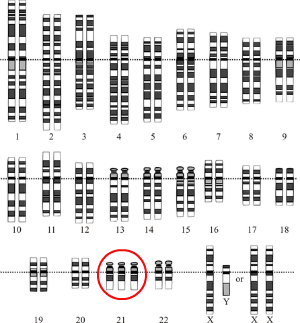On the Origins of New Forms of Life
4.5: Aneuploidy
(Continued from the previous page)
Aneuploidy is produced by multiplication or deletion of individual chromosomes. For example, a diploid organism with a chromosome count of 2n might produce an aneuploid offspring with an extra copy of one chromosome (so the total chromosome count would be 2n + 1). It might also produce an offspring that lacked a copy (so the count would be 2n - 1).1 The addition or subtraction of a single chromosome often has an affect on multiple characters. Torrey's willowherb (Epilobium torreyi2) is an example of a form derived from aneuploidization.3 It is thought to be an aneuploid derivative of largeflower spike-primrose (E. pallidum4).
One example of aneuploidization, Down's syndrome, has already been mentioned. Down's syndrome arises when a gamete containing an extra copy of chromosome 21, usually an egg from an older mother, combines with a gamete containing the normal complement of human chromosomes. The result is an individual with three copies of Chromosome 21. Such gametes result from a mistake in meiosis ("nondisjunction") in which a gamete receives both members of a chromosome pair instead of only one as usually occurs. Males with Down's syndrome are in general far less fertile than individuals with a normal human karyotype, but they do produce some viable gametes.5 Females are quite fertile, and 50 percent of their eggs carry two copies of Chromosome 21. There is the potential, then, for such an aneuploid egg to combine on rare occasion with a similarly aneuploid spermatozoon from a male Down's individual to produce a reproductively stable type with a fully paired karyotype. In this way, if this new type were viable, a stabilization process could at least hypothetically, produce a new, fertile type with a chromosome count of 2n = 48 (instead of the normal 46). It is hard to assess just how often new forms arise via the addition or deletion of individual chromosomes, but this issue is discussed briefly in Appendix D.
Notes
1. Reductions and increases in chromosome numbers due to chromosome breakages and fusions are also often described under the heading of aneuploidization (e.g., Grant 1982: 359–361), but here will be placed under the heading of chromosomal rearrangements.
2. Epilobium torreyi is called Boisduvalia stricta by Seavy (1992).
3. Seavey (1992).
4. Epilobium pallidum is called Boisduvalia macrantha by Seavy (1992).
5. Sheridan et al. (1989).
